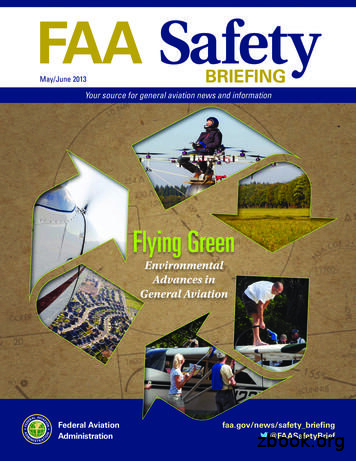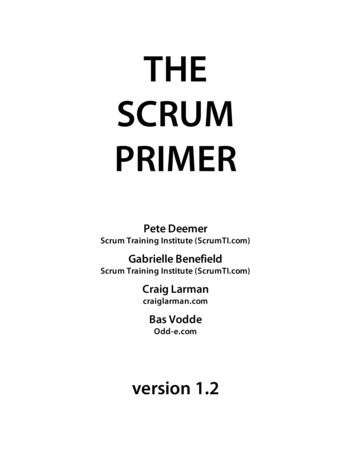Briefing On Update To FAA AC 150/5390-2D Heliports
Briefing on Update toFAA AC 150/5390-2D HeliportsRobert BasseyFAA Airport Engineering Division, AAS-100FAAOffice of Airport
AgendaOverview of Heliport Design Advisory Circular (AC)Heliport Design ComponentsFAA Notification of Heliport Construction or AlterationTimeline for completion of Draft ACFAAOffice of Airport
CaveatThis summary briefing presents preliminary draft information for theHeliport Design AC and is subject to change.Industry review and comment period is pending once draft AC isdistributed to helicopter industry organizations and interested parties.FAAOffice of Airport
Overview of Heliport Design ACFAAOffice of Airport
Purpose of the Heliports Design ACTo provide a comprehensive guide on heliport design toheliport owners and operators for all types of heliports.FAAOffice of Airport
3 Heliport Types1. General Aviation (includes PPR heliports)2. Transport Heliports3. Hospital HeliportsEach type of heliport has unique design elements.This AC includes specific design criteria for each heliport type.FAAOffice of Airport
AC Table of ContentsChapter 1: IntroductionChapter 2: Heliport DesignChapter 3: Heliport Taxiways, Taxi Routes and Helicopter ParkingChapter 4: Heliport Markings and LightingChapter 5: Heliport Facilities on AirportsChapter 6: Instrument OperationsChapter 7: Heliport Site Safety ElementsFAAOffice of Airport
Heliport Design ComponentsFAAOffice of Airport
Basic Heliport Facilities1. TLOF: Touchdown and Liftoff Area (TLOF)2. Final Approach and Takeoff Area (FATO)3. Safety Area4. Approach/Departure SurfacesWind coneTLOFFATOSafety AreaApproach/departuresurfaceFAAOffice of Airport
Circular, see note 1HeliportDimensionsEFBSquare, see note 2Specific minimum dimensions areprovided for TLOF, FATO and SafetyArea for each type of heliport.ACRectangle, see note 3GTLOFFATOSafety AreaFAAOffice of Airport
TLOF/FATO Minimum DimensionsDimItemGATRANSPORTHOSPITALATLOF Length1 RD1 RD but not less than50 ft (15 m)1 RD but not less than40 ft (12 m)BTLOF Width1 RD1 RD but not less than50 ft (15 m)1 RD but not less than40 ft (12 m)CFATO Length1½D2 RD but not less than200 ft (60 m)1½DEFATO Width1½D2 RD but not less than100 ft (30 m)1½DFSeparation between TLOF and FATOperimeters¾ D – ½ RD¾ D – ½ RD¾ D – ½ RDGSafety Area WidthSee Table 2-4½ RD but not less than30 ft (9 m)See Table 2-5FAAOffice of Airport
HeliportApproach/DepartureSurfacesPreferred approach/departuresurface based up on thepredominate wind directionSee liport135Shaded areato have samecharacteristicsas FATO500 ft [152 m]250 ft [76 m]500 ft[152 m]On-ShoreParking Apron4,000 ft[1,219 m]250 ft[76 m]500 ft[152 m]8:1 Approach/DepartureSurfaceFAA2:1 Transitional SurfaceFATOOffice of Airport
TLOF perimeter marking12 in [30 cm] widewhite lineTypicalHeliportMarkingsTouchdown position circleinner diameter-1/2 D ofdesign helicopter18 in [46 cm] wideyellow lineSee Note 1See Note 2Marking Example 1 TLOF size equals 1 RD of design helicopterTouchdown positioncircle inner diameter1/2 D of design helicopter18 in [46 cm] wideyellow lineTLOF perimetermarking12 in [30 cm] widewhite lineSee Note 1See Note 2Marking detail - Example 2Touchdown positioncircle inner diameter1/2 D of designhelicopter18 in [46 cm] wideyellow lineTLOF perimetermarking12 in [30 cm] widewhite lineSee Note 1See Note 2FAAMarking detail - Example 3Office of Airport
HeliportLightingLighted wind cone5 Approach lights (Optional)See Note 1 for detailsPreferred approach15 ft (4.6m)25 ftmaxIn-pavement FATOedge lights25 ft (7.6m)maxIn-pavement TLOF edge lights1 ft [30 cm]In-pavement edge light detailTLOFFATOFAAOffice of Airport
Instrument Operations Instrument procedures allow for helicopter operations during low cloudceilings and/or reduced visibility Instrument procedures include approach procedures, departure procedures,and missed approach procedures Specific requirements depend on the type of instrument procedure: Precision approach Non-precision approach Approach to point-in-spaceFAAOffice of Airport
FAA Notification of Heliport Construction or AlterationFAAOffice of Airport
FAA Form 7480-1 and Process Submit form at least 90 days prior to construction, alteration, or change inheliport Include a heliport layout plan FAA conducts aeronautical study per Part 157 regulationFAAOffice of Airport
FAA HeliportEvaluation ProcessFlow ChartNote: Flow chart isdraft only and iscurrently being revisedProponent desiresa heliportADO unlocks theRegional NextGenBranch (RNGB) forcomment in iOE/AAARNGB completes theFlight Standardsresponse to the ADOProponentelectronicallysubmits to ADOthe 7480-1,sketch, mapOEAAA notifies theFlight StandardsDivision Office(FSDO)ADO issues a letterof determinationAirports DivisionSpecialist reviewsprovided dataIf required, assignedAviation Safety Inspector(ASI) completes theinspection and forwardsthe results to the RNGBLetter of Determinationand FAA Form 5010-3/5are forwarded to theproponent for completionProponent returnscompleted 5010 to theADOADO forwardsinformation toNational Flight DataCenter (NFDC)NFDC completes HeliportID and issues toproponentProponent receivesheliport location IDProponentcompletes annualobstacle inspectionProponent notifies RNGB/ADO of any changesProcess completeFAAOffice of Airport
Schedule for Revised Heliport Design ACFAAOffice of Airport
Approximate Timeline for Completion of Draft AC1. Industry Review period (January-April 2021)2. Adjudication of industry comments (May 2021)3. Complete final draft AC (June 2021)4. Legal review (June-July 2021)5. Adjudication of Legal Review comments (August 2021)6. Publish final AC (September 2021)FAAOffice of Airport
Summary of Changes to Heliport Design ACFAAOffice of Airport
Summary of Changes to Heliports AC1. Separate chapters on General Aviation, Transport and Hospital Heliports arenow consolidated into one chapter2. Eliminate redundant information3. Clearly present design guidance for each heliport component4. Add separate chapters for Taxiways / Heliport Marking and Lighting5. Improve figures6. Include HyperlinksFAAOffice of Airport
Example of Consolidated Table for all 3 Heliport TypesTable 2-1. TLOF/FATO Minimum DimensionsDimItemGATRANSPORTHOSPITALATLOF Length1 RDBTLOF Width1 RDCFATO Length1½D11 RD but not less than50 ft (15 m)1 RD but not less than50 ft (15 m)2 RD but not less than200 ft (60 m)1 RD but not less than40 ft (12 m)1 RD but not less than40 ft (12 m)1½D1EFATO Width1½D1½DFSeparation betweenTLOF and FATO perimetersSafety Area Width¾ D – ½ RD2 RD but not less than100 ft (30 m)¾ D – ½ RDGSee Table 2-8½ RD but not less than30 ft (9 m)¾ D – ½ RDSee Table 2-9FAAOffice of Airport
Enhanced/Simplified FiguresCurrent AC figureNew AC figureEarhart AvenueEARHART AVENUEAuto parking areaAUTO PARKING AREACITY PROPERTYCITY PROPERTYNOFFICEFUTURE HELICOPTER PARKINGCityPropertyOfficeCityPropertyFuture helicopter parkingFATO LIGHTSFLUSH TLOF PERIMETER LIGHTSLANDING CH/DEPARTURESURFACEIN-GROUND FATO EDGE MARKERSSAFETY AREAHeliport property lineHELIPORT PROPERTY LINENote: Draw layout diagramsto scale with key dimensions shown as TLOF size, FATOsize, safety area size, distances from safety area perimeter to property edges, etc.TLOFFATOSafety AreaApproach/departuresurfaceFAAOffice of Airport
Example of Consolidated Figures and TablesFAAOffice of Airport
Comments and Questions?FAAOffice of Airport
Briefing on Update to FAA AC 150/5390-2D Heliports Robert Bassey FAA Airport Engineering Division, AAS-100. FAA Office of Airport . (May 2021) 3. Complete final draft AC (June 2021) 4. Legal review (June-July 2021) 5. Adjudication of Legal Review comments (August 2021) 6.
FAA-H-8083-3 Airplane Flying Handbook FAA-H-8083-6 Advanced Avionics Handbook FAA-H-8083-9 Aviation Instructor's Handbook FAA-H-8083-15 Instrument Flying Handbook FAA-H-8083-16 Instrument Procedures Handbook FAA-H-8083-25 Pilot's Handbook of Aeronautical Knowledge FAA-H-8083-30 Aviation Maintenance Technician Handbook— General FAA-H-8083 .
From: Vantrees, Stephen (FAA) stephen.vantrees@faa.gov Sent: Thursday, March 19, 2020 8:17 AM To: White, Peter (FAA) peter.white@faa.gov Cc: Vantrees, Stephen (FAA) stephen.vantrees@faa.gov Subject: Fw: Actions from 3/12/2020 Meeting: AVS/ATO Executive Coordination on NASA/General Atomics SIO
SUBJECT: Briefing: FAA NextGEN, and LAZIR-B Proposal-Flight Patterns . . Letter dated June 7, 2016 from the FAA Administrator to Congressman Van Hollen ( 12-13) Letter dated May 9, 2016 from the FAA Eastern Regional Administrator to William . Federal Aviation Administration (FAA) has held for Montgomery County residents and it is .
FAA-H-8083-9 Aviation Instructor’s Handbook FAA-S-8081-4 Instrument Rating Practical Test Standards FAA-S-8081-12Commercial Pilot Practical Test Standards FAA-S-8081-14Private Pilot Practical Test Standards FAA-H-8083-15Instrument Flying Handbook FAA/AS
ASRS Program Briefing. Last Updated: June 2018. ASRS Program Briefing Index. ASRS Program Overview 3 Report Processing 11 . the Secretary's Task Force on the FAA Safety Mission May 1975 Aviation Safety Reporting Program (ASRP) Implemented (FAA) . Implemented (FAA) May 9, 1975 Advisory Circular 00-46A Issued Apr. 1976 Aviation Safety .
lers Association (NATCA) awarded a dozen FAA . and rotorcraft are expected to grow 2.8 percent and . May/June 2013 FAA. Safety Briefing 3 2.7 percent per year respectively, fixed-wing piston . popular features of faa.gov,, including: N-number inquiry, U.S. airport status and delays,
FAA Office of Airport Briefing on Update to . FAA AC 150/5390- 2D . Heliports. Robert Bassey. . (150/5xxx) advisory circulars - Standards for airport design, safety, construction, equipment, airfield lighting, signage and marking, and airfield pavements that are required for projects using . (June 2021) 4. Legal review (June-July 2021) 5.
Agile Development and Scrum The agile family of development methods were born out of a belief that an approach more grounded in human reality – and the product development reality of learning, innovation, and change – would yield better results. Agile principles emphasize building working software that























